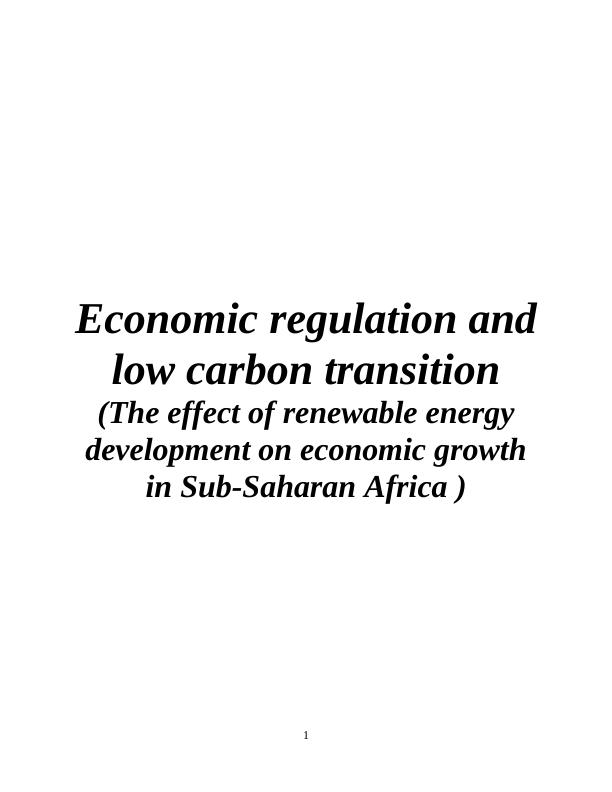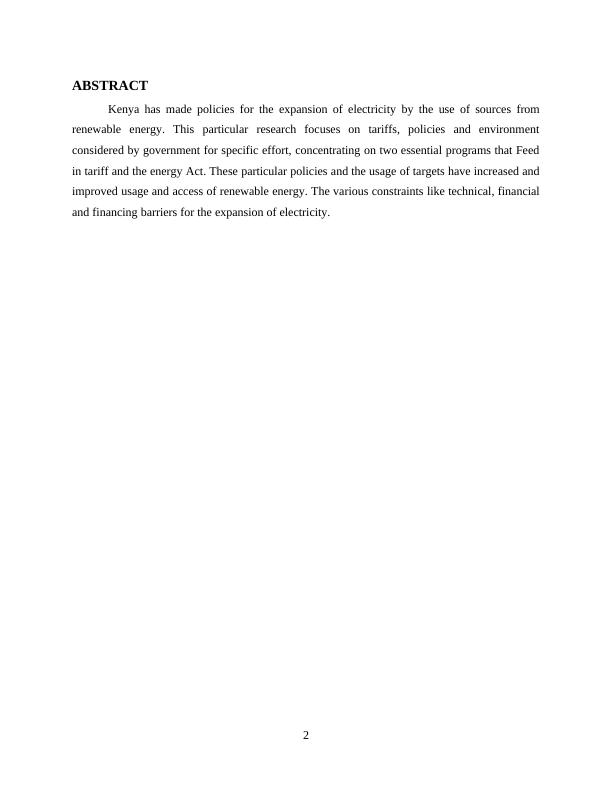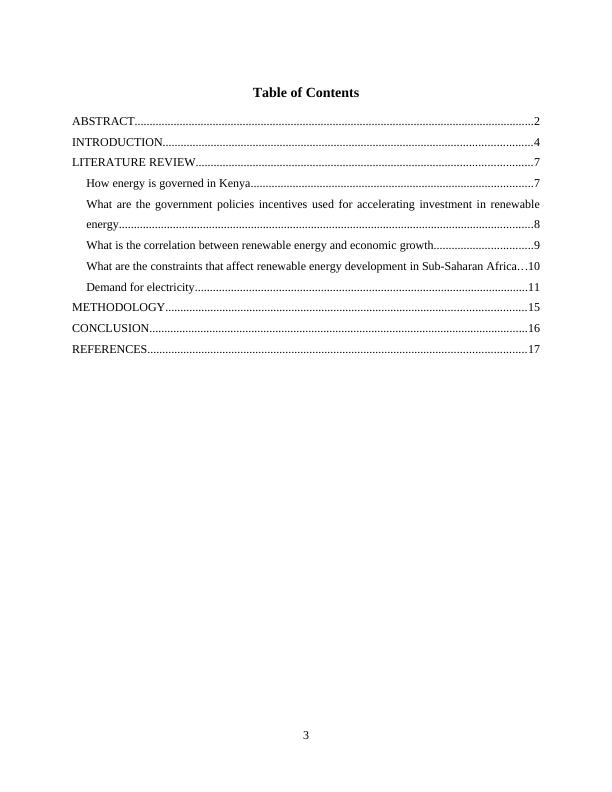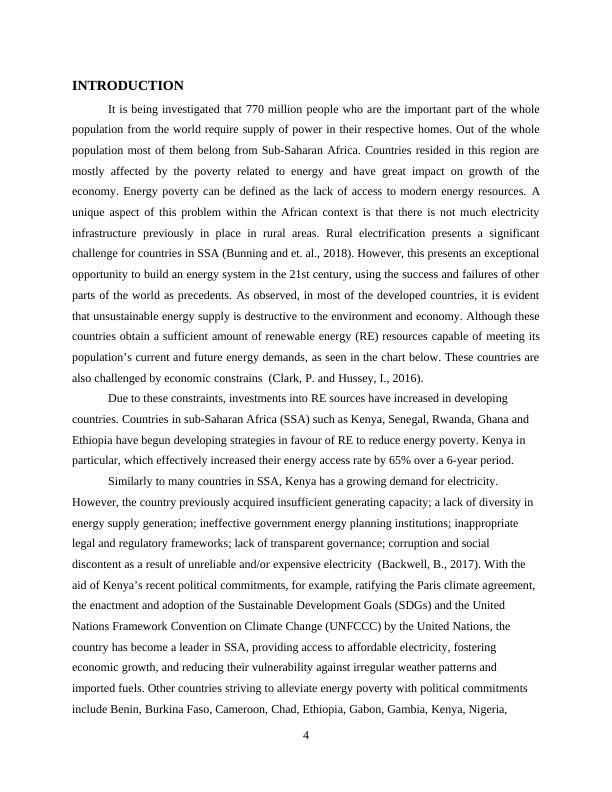The Effect of Renewable Energy Development on Economic Growth in Sub-Saharan Africa
Added on 2022-12-19
18 Pages4941 Words5 Views
Economic regulation and
low carbon transition
(The effect of renewable energy
development on economic growth
in Sub-Saharan Africa )
1
low carbon transition
(The effect of renewable energy
development on economic growth
in Sub-Saharan Africa )
1

ABSTRACT
Kenya has made policies for the expansion of electricity by the use of sources from
renewable energy. This particular research focuses on tariffs, policies and environment
considered by government for specific effort, concentrating on two essential programs that Feed
in tariff and the energy Act. These particular policies and the usage of targets have increased and
improved usage and access of renewable energy. The various constraints like technical, financial
and financing barriers for the expansion of electricity.
2
Kenya has made policies for the expansion of electricity by the use of sources from
renewable energy. This particular research focuses on tariffs, policies and environment
considered by government for specific effort, concentrating on two essential programs that Feed
in tariff and the energy Act. These particular policies and the usage of targets have increased and
improved usage and access of renewable energy. The various constraints like technical, financial
and financing barriers for the expansion of electricity.
2

Table of Contents
ABSTRACT.....................................................................................................................................2
INTRODUCTION...........................................................................................................................4
LITERATURE REVIEW................................................................................................................7
How energy is governed in Kenya..............................................................................................7
What are the government policies incentives used for accelerating investment in renewable
energy..........................................................................................................................................8
What is the correlation between renewable energy and economic growth.................................9
What are the constraints that affect renewable energy development in Sub-Saharan Africa...10
Demand for electricity...............................................................................................................11
METHODOLOGY........................................................................................................................15
CONCLUSION..............................................................................................................................16
REFERENCES..............................................................................................................................17
3
ABSTRACT.....................................................................................................................................2
INTRODUCTION...........................................................................................................................4
LITERATURE REVIEW................................................................................................................7
How energy is governed in Kenya..............................................................................................7
What are the government policies incentives used for accelerating investment in renewable
energy..........................................................................................................................................8
What is the correlation between renewable energy and economic growth.................................9
What are the constraints that affect renewable energy development in Sub-Saharan Africa...10
Demand for electricity...............................................................................................................11
METHODOLOGY........................................................................................................................15
CONCLUSION..............................................................................................................................16
REFERENCES..............................................................................................................................17
3

INTRODUCTION
It is being investigated that 770 million people who are the important part of the whole
population from the world require supply of power in their respective homes. Out of the whole
population most of them belong from Sub-Saharan Africa. Countries resided in this region are
mostly affected by the poverty related to energy and have great impact on growth of the
economy. Energy poverty can be defined as the lack of access to modern energy resources. A
unique aspect of this problem within the African context is that there is not much electricity
infrastructure previously in place in rural areas. Rural electrification presents a significant
challenge for countries in SSA (Bunning and et. al., 2018). However, this presents an exceptional
opportunity to build an energy system in the 21st century, using the success and failures of other
parts of the world as precedents. As observed, in most of the developed countries, it is evident
that unsustainable energy supply is destructive to the environment and economy. Although these
countries obtain a sufficient amount of renewable energy (RE) resources capable of meeting its
population’s current and future energy demands, as seen in the chart below. These countries are
also challenged by economic constrains (Clark, P. and Hussey, I., 2016).
Due to these constraints, investments into RE sources have increased in developing
countries. Countries in sub-Saharan Africa (SSA) such as Kenya, Senegal, Rwanda, Ghana and
Ethiopia have begun developing strategies in favour of RE to reduce energy poverty. Kenya in
particular, which effectively increased their energy access rate by 65% over a 6-year period.
Similarly to many countries in SSA, Kenya has a growing demand for electricity.
However, the country previously acquired insufficient generating capacity; a lack of diversity in
energy supply generation; ineffective government energy planning institutions; inappropriate
legal and regulatory frameworks; lack of transparent governance; corruption and social
discontent as a result of unreliable and/or expensive electricity (Backwell, B., 2017). With the
aid of Kenya’s recent political commitments, for example, ratifying the Paris climate agreement,
the enactment and adoption of the Sustainable Development Goals (SDGs) and the United
Nations Framework Convention on Climate Change (UNFCCC) by the United Nations, the
country has become a leader in SSA, providing access to affordable electricity, fostering
economic growth, and reducing their vulnerability against irregular weather patterns and
imported fuels. Other countries striving to alleviate energy poverty with political commitments
include Benin, Burkina Faso, Cameroon, Chad, Ethiopia, Gabon, Gambia, Kenya, Nigeria,
4
It is being investigated that 770 million people who are the important part of the whole
population from the world require supply of power in their respective homes. Out of the whole
population most of them belong from Sub-Saharan Africa. Countries resided in this region are
mostly affected by the poverty related to energy and have great impact on growth of the
economy. Energy poverty can be defined as the lack of access to modern energy resources. A
unique aspect of this problem within the African context is that there is not much electricity
infrastructure previously in place in rural areas. Rural electrification presents a significant
challenge for countries in SSA (Bunning and et. al., 2018). However, this presents an exceptional
opportunity to build an energy system in the 21st century, using the success and failures of other
parts of the world as precedents. As observed, in most of the developed countries, it is evident
that unsustainable energy supply is destructive to the environment and economy. Although these
countries obtain a sufficient amount of renewable energy (RE) resources capable of meeting its
population’s current and future energy demands, as seen in the chart below. These countries are
also challenged by economic constrains (Clark, P. and Hussey, I., 2016).
Due to these constraints, investments into RE sources have increased in developing
countries. Countries in sub-Saharan Africa (SSA) such as Kenya, Senegal, Rwanda, Ghana and
Ethiopia have begun developing strategies in favour of RE to reduce energy poverty. Kenya in
particular, which effectively increased their energy access rate by 65% over a 6-year period.
Similarly to many countries in SSA, Kenya has a growing demand for electricity.
However, the country previously acquired insufficient generating capacity; a lack of diversity in
energy supply generation; ineffective government energy planning institutions; inappropriate
legal and regulatory frameworks; lack of transparent governance; corruption and social
discontent as a result of unreliable and/or expensive electricity (Backwell, B., 2017). With the
aid of Kenya’s recent political commitments, for example, ratifying the Paris climate agreement,
the enactment and adoption of the Sustainable Development Goals (SDGs) and the United
Nations Framework Convention on Climate Change (UNFCCC) by the United Nations, the
country has become a leader in SSA, providing access to affordable electricity, fostering
economic growth, and reducing their vulnerability against irregular weather patterns and
imported fuels. Other countries striving to alleviate energy poverty with political commitments
include Benin, Burkina Faso, Cameroon, Chad, Ethiopia, Gabon, Gambia, Kenya, Nigeria,
4

End of preview
Want to access all the pages? Upload your documents or become a member.
Related Documents
Green Energy Techniques in Sub-Saharan Africalg...
|7
|1341
|62
China should expand bilateral trade with Sub-Saharan Africalg...
|6
|1785
|203
Concentrated Solar Power in Africalg...
|19
|4581
|65
HI5003 - Demand and Supply of Copper in Australia - Reportlg...
|8
|1556
|46
